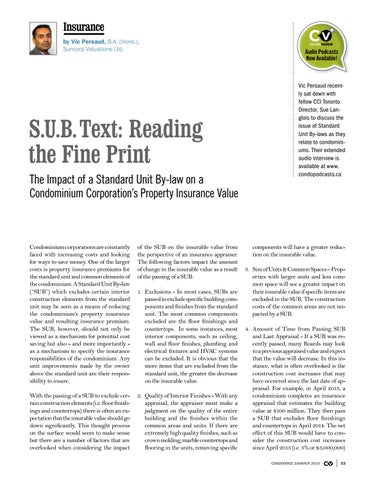Insurance
+
by Vic Persaud, B.A. (Hons.), Suncorp Valuations Ltd.
S.U.B. Text: Reading the Fine Print The Impact of a Standard Unit By-law on a Condominium Corporation’s Property Insurance Value
Condominium corporations are constantly faced with increasing costs and looking for ways to save money. One of the larger costs is property insurance premiums for the standard unit and common elements of the condominium. A Standard Unit By-law (“SUB”) which excludes certain interior construction elements from the standard unit may be seen as a means of reducing the condominium’s property insurance value and resulting insurance premium. The SUB, however, should not only be viewed as a mechanism for potential cost saving but also - and more importantly as a mechanism to specify the insurance responsibilities of the condominium. Any unit improvements made by the owner above the standard unit are their responsibility to insure.
of the SUB on the insurable value from the perspective of an insurance appraiser. The following factors impact the amount of change in the insurable value as a result of the passing of a SUB:
With the passing of a SUB to exclude certain construction elements (i.e. floor finishings and countertops) there is often an expectation that the insurable value should go down significantly. This thought process on the surface would seem to make sense but there are a number of factors that are overlooked when considering the impact
2. Quality of Interior Finishes - With any appraisal, the appraiser must make a judgment on the quality of the entire building and the finishes within the common areas and units. If there are extremely high quality finishes, such as crown molding, marble countertops and flooring in the units, removing specific
1. Exclusions - In most cases, SUBs are passed to exclude specific building components and finishes from the standard unit. The most common components excluded are the floor finishings and countertops. In some instances, most interior components, such as ceiling, wall and floor finishes, plumbing and electrical fixtures and HVAC systems can be excluded. It is obvious that the more items that are excluded from the standard unit, the greater the decrease on the insurable value.
CV
condovoice
Audio Podcasts Now Available!
Vic Persaud recently sat down with fellow CCI Toronto Director, Sue Langlois to discuss the issue of Standard Unit By-laws as they relate to condominiums. Their extended audio interview is available at www. condopodcasts.ca
components will have a greater reduction on the insurable value. 3. Size of Units & Common Spaces – Properties with larger units and less common space will see a greater impact on their insurable value if specific items are excluded in the SUB. The construction costs of the common areas are not impacted by a SUB. 4. Amount of Time from Passing SUB and Last Appraisal - If a SUB was recently passed, many Boards may look to a previous appraised value and expect that the value will decrease. In this instance, what is often overlooked is the construction cost increases that may have occurred since the last date of appraisal. For example, in April 2013, a condominium completes an insurance appraisal that estimates the building value at $100 million. They then pass a SUB that excludes floor finishings and countertops in April 2014. The net effect of this SUB would have to consider the construction cost increases since April 2013 (i.e. 3% or $3,000,000) CONDOVOICE SUMMER 2016
CV
53
